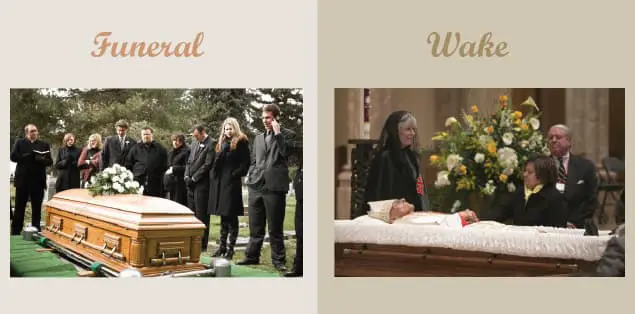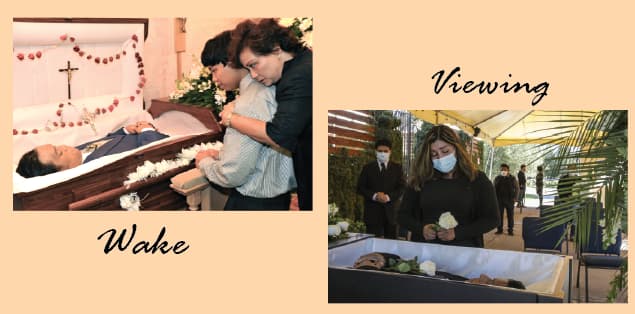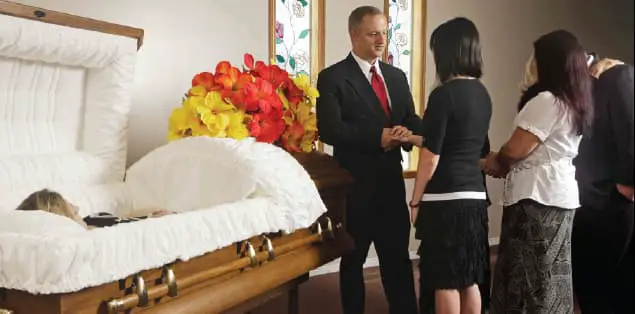Wakes began as post-mortem vigils, a method to keep an eye on a loved one after they die and spend a private moment with them before burial. Wakes used to be held in private homes, but nowadays, they are much more commonly held at funeral homes.
A funeral, viewing, and wake all have many similarities. They’re all ways to pay tribute to a loved one’s life in a specific and unique way that reflects who they were and what they meant to the world. There are a few significant changes as well.
What Is a Wake Instead of a Funeral Service?

A traditional or religious funeral service is not for everyone. Instructions for formal funeral service preparations can be left behind by a deceased, which can be very beneficial to loved ones in charge of preparing a funeral for a lost loved one.
It is possible that the person who would choose a wake rather than a church hall funeral ceremony was given these instructions. They can still be cremated or buried, but no formal service will be held. Instead, they’ll want close friends and family home to gather at a wake to commemorate their lives and console one another.
Why Is It Called a Wake?
The word “wake” originally meant “watch,” “vigil,” or “guard” in reference to death. It was a term for a prayer sitting vigil, which was frequently held late at night or overnight, during which mourners would maintain watch over their loved ones until they were laid to rest.
A wake typically features prayers, family comfort, and a final opportunity to see and contact the deceased. After the family finished the vigil, some wakes included feasting and merriment.
Depending on where you are in the world, the word can also have diverse connotations. For example, in the United Kingdom, a wake has evolved to refer to a social gathering shortly after the funeral services and burial or cremation. A funeral reception is another name for it. Mourners will reminisce, honor the deceased person’s life, and enjoy refreshments in the person’s home or at a location offsite. It’s a more relaxed, social event than a funeral.
However, in the United States, wakes tend to denote the viewing or visitation of a recently deceased person as an informal event. This is where family members and close friends are typically present and pay their respects to the dead, who may be buried in an open casket in a funeral home or their own house.
They pay a visit to say their final goodbyes, spend time, and share memories and their emotions. The visitation or wake, which usually takes place one or two evenings before the funeral, may include prayers or other ceremonies.
Where Does the Word Wake Come From?
People first used the term “wake” to refer to a prayer vigil, commonly held on the feast day of the saint to whom a parish church was dedicated. In many nations, a wake is now largely linked with the social events surrounding a funeral. The association with prayer has faded over time.
In many Celtic areas in Europe, mourners were customary to keep watch or vigil over their dead until they were buried, a practice known as an “Irish wake.” This is still prevalent in Ireland, northwestern Scotland, and northern England.
With the more modern tradition of hosting the wake at a funeral home rather than at the family’s home, the custom of serving refreshments to the mourners is typically led immediately following the funeral at the house or another convenient venue.
In Irish culture, the wake, or seeing the body shortly, is essential for the death process. This ceremony allows the living to have one last interaction with the departed, allowing them to express their feelings and offer condolences and ideas about the person’s death.
Is a Wake Held in the Funeral Home?
Wakes used to be held at people’s homes, but these days they’re more typically hosted in funeral homes. Some people choose to have them in a church’s social hall. A wake is a social gathering held before a funeral to commemorate a person’s death. A wake is traditionally held in the deceased’s home with the body present; however, nowadays, wakes are frequently held at a funeral home or another suitable venue.
A wake is often conducted instead of a funeral as a social celebration of the person’s life. It’s synonymous with viewing in the United States and Canada. It’s frequently a social rite that emphasizes the idea that the loss impacts the entire social community.
How Can Family Members Hold a Wake?
1. Decide Who to Invite to a Wake
A wake can be private or public, so think about who you’d like to invite before making any arrangements. If guests cannot attend the funeral service, they may choose to participate in the wake.
2. Choose Where to Hold a Wake
You can hold the wake anywhere you want. Keep in mind how many guests will be attending. Some of the more common wake venues are:
- Your own home
- Family home
- Church halls
- Social club
3. Prepare Food, and Drink
People usually serve food at a wake. If they want to serve their loved one’s favorite cuisine and drink, they can do so as many venues are willing to accommodate such requests.
Depending on the venue, they may already include catering in the booking fee. If it isn’t, you can prepare your meal or ask visitors to bring a dish to share.
What to Wear at Wake?
Knowing what to wear helps alleviate some stress, as no one wants to appear incorrectly. Another way to express your respect for the deceased and their family is by what you wear.
Black apparel, muted tones, and work attire are always safe bets for women. Slacks and a blouse or sweater work well as well. You should avoid clothing that attracts attention or is extravagant, as it is inappropriate for a wake.
For a wake, men should wear a suit and tie or a shirt and tie. A sweater and decent pants, or a button-down shirt in black or dark, subdued hues with formal pants, are all acceptable options. It is not appropriate to wear bright colors or casual attire such as t-shirts or jeans.
What Is a Wake vs Viewing?

A viewing is an informal gathering of a close friend and family members who come to pay their respects to the deceased, who a mortician has prepared, or to a cremation urn or set of memorial images. In comparison to a funeral, a viewing is usually a more relaxed occasion.
Why Have a Viewing?
A viewing allows mourners to express their sadness, offer support, and say their goodbyes personally. This is also a significant occasion for paying your respects to the family. Over the years, the name of the viewing has changed several times. It’s known as “calling hours” if you’re of a specific generation. It’s referred to be a visitation by some.
What Is Wake?
The wake is traditionally a Catholic ceremony based partly on Irish Celtic traditions. According to those customs, family and close friends were expected to stay awake all night with the deceased to protect them from evil spirits. Once the burial finishes, it means that the deceased is now safe.
A wake may involve a brief ritual led by a priest in the Catholic tradition. The priest may recite scriptures or say prayers (typically the rosary). The wake is referred to as a “rosary” in this stricter Catholic definition.
In many ways, modern wakes are similar to viewing because it allows other mourners to express their condolences and share their sadness in a less formal setting.
Final Words – What is a Wake?
It’snever easy to say goodbye to loved ones for the grieving family. Still, it might feel smoother and more tranquil when you’re surrounded by family and friends and can construct a personal and special tribute.
You have many unique memorial services alternatives at your disposal. You may mix customs, disposition techniques, and forms of celebration to create a service that best speaks to the deceased and lets their friends and family member say their goodbyes comfortably and quietly.
Confused if you should host a funeral or memorial service? Consider your budget, their end-of-life plan, the method of disposition, and what they would have most loved or requested to build a hopeful and personalized tribute that will help you and your community find peace. Also, ever wondered why do people wear black at funerals? Check out the answer!
